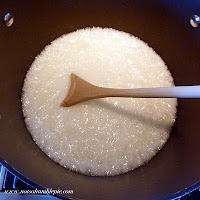Instead of biting into a caramel-like, semi-hard candy with a fine sugary grain that immediately melts in your mouth; I bit into a soft, creamy, smooth candy that reminded me more of frosting than candy. This new-to-me type of fudge also melts in your mouth, but I did not care for it (much to the delight of my husband and children).
So, after a couple of years of not thinking about it, I suddenly really started to wonder about the difference. How did we come to use the same word for different types of candy? Surely the South Africa version is "real" fudge and the Americans did with a perfectly good confection exactly what they did with the English language - they fudged it! There had to be a similarity though, because they look very similar. After a bit of reading on the Internet (and I mean a bit, I am really not into doing a doctor's thesis on this subject!) here is what I have found out:
- Apparently fudge was invented in America, so what I know as fudge is indeed not "real" fudge - if you want to get all hung up on it, not that I would.
- What I grew up making and eating as a child is also known as "Scottish tablet" or "Swiss Milk tablet". If you want to find out more about the history of this candy read this interesting blog: The Art and Mystery of Food: Scottish Tablet and Russian Toffee.
- Tablet has a longer history than fudge and evolved from a toffee recipe (as described in the above referenced blog).
- Fudge, on the other hand, seemed to have come about from literally fudging a batch of caramels according to The Nibble.com.
- The core or original ingredients of tablet is sugar and sour cream boiled together in a specific way.
- The core or original ingredients of fudge is sugar and cream boiled together in a specific way. I guess that answers my question as to why they look so similar.
- Both fudge and tablet's ingredients only have sugar in common with the original versions.
A small note on the photographs: They are not mine so please visit the blog where I got them from. I simply cannot make a batch of fudge at this time due to time and diet constraints. Not So Humble Pie.com. Please also read her version of the recipe. Ms. Humble's version is more involved and more suited for those who are very good cooks and like to do stuff without "cheating". My version, makes it easier for people new to this kind of candy and does not require you to have a candy thermometer. You will notice a slight difference in our ingredients too.
South African Fudge:
Ingredients:
4 lbs white sugar
1 can of sweetened condensed milk (Carnation, Eagle Brand or Publix store brand worked well for me)
2 cans of whole milk (use the empty condensed milk can to measure out the milk)
2 teaspoons of salt
1/2 lb of butter (or margarine but butter is preferable)
3 tablespoons of golden syrup. (I used Aunt Jamima's original pancake syrup in the US. In South Africa we use golden syrup that is a by product of cane sugar production. It is thick, sticky, doesn't have corn syrup in it and doesn't pour. Tate and Lyle's Golden Syrup is the brand I grew up with. You can buy a pourable version it here and here or the classic version here.)
Tools:
A large, 8 quart, heavy bottomed pot.
Long stem wooden spoon.
Cookie sheet 13" x 16" or thereabouts (the larger the pan, the thinner the fudge will be)
Cooking spray or butter to grease the sheet.
Method:
1. Combine all the ingredients in a large pot and stir until all the sugar is wet.

2. Heat on medium to low heat until all the sugar is melted and you have a smooth, shiny, white mixture in the pot. It should look like this
3. Turn up the heat to medium high to high for 25 - 30 minutes. Stir at all times. The mixture can burn to the bottom if not stirred. At this point the mixture will probably double in size, then slowly darken to a caramel brown as the time passes and finally settling back to the same or a similar size as it was before it started to boil. Here is what it would look like during the process
 |
| a. In the beginning it stays white. |
 |
| b. Notice the slight browning. |
 | ||||||
| c. Browning some more. |
4. At the end of the allocated time the mixture should separate from the side of the pot as you stir it. You will also notice that the candy crystallizes on the side of the pot.
5. Pour in the vanilla extract and stir until mixed in. This shows what it will look like when you pour in the vanilla.
 |
| What it looks like after stirring in the vanilla , just before pouring. |
7. Pour into the greased cookie sheet.
 |
| In the pan ready to be cut |
Notice this fudge is darker than Ms. Humble's. Mine usually comes out this dark.
I hope you enjoy making your own version of the fudge. Remember, this is definitely a moment on the lips and lifetime on the hips type of candy. It is also highly moreish, so store under lock and key. I take no responsibility if you cannot stop eating it.
If you have any additional information about the topic, especially on the history of both types of candy, want to correct any misinformation, grammar, spelling, cooking terminology or just have a link or a recipe on the topic to share, please do so! I'd love to hear from you.

